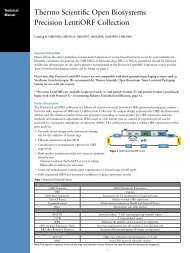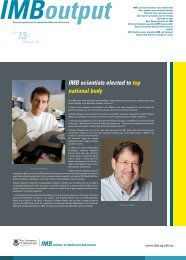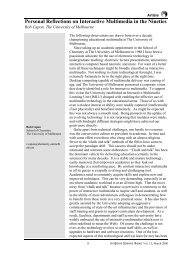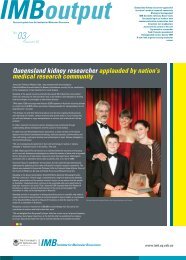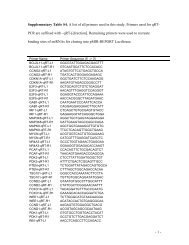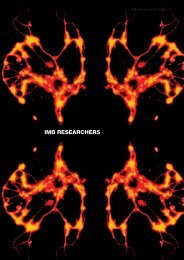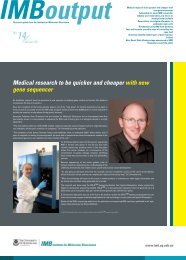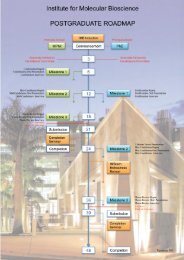2010 Annual Report - Institute for Molecular Bioscience - University ...
2010 Annual Report - Institute for Molecular Bioscience - University ...
2010 Annual Report - Institute for Molecular Bioscience - University ...
Create successful ePaper yourself
Turn your PDF publications into a flip-book with our unique Google optimized e-Paper software.
imb annual report <strong>2010</strong><br />
36<br />
RICK STURM<br />
MELANOGENIX RESEARCH GROUP<br />
THE MELANOGENIX (MELANOCYTE<br />
biology and pigmentation genetics)<br />
laboratory is studying the molecular,<br />
genetic and cellular basis underlying<br />
normal human variation in the pigmentary<br />
traits of skin, hair and eye colour. Several<br />
genome-wide association studies<br />
(GWAS) <strong>for</strong> pigmentation have now been<br />
conducted and identified SNP markers in<br />
known (TYR, TYRP1, OCA2, SLC45A2,<br />
SLC24A5, MC1R, ASIP, KITLG) and<br />
previously unknown (SLC24A4, IRF4,<br />
TPCN2) candidate genes. We have<br />
investigated skin and hair colour genetic<br />
associations in Europeans, and discovered<br />
that responsible polymorphisms are found<br />
within a range of pigmentation genes,<br />
whereas blue-brown eye colour can be<br />
explained by a single SNP proposed to<br />
regulate OCA2 expression. There is a<br />
strong genotype-by-age effect of IRF4 on<br />
nevus count, and the responsible SNP is<br />
associated with increased melanoma risk.<br />
In addition, we have found that this SNP<br />
can modulate the transcriptional expression<br />
of the IRF4 gene in melanocytes.<br />
Functional analysis of the human<br />
pigmentation gene set will ultimately<br />
provide a full appreciation of this biological<br />
system linking genotype with phenotype.<br />
Specifically the role of the MC1R gene<br />
variants in directing skin phototype and<br />
response to UV-induced ligand binding<br />
and receptor activation is a major area<br />
of investigation. In addition, the group<br />
is studying the process of development<br />
and differentiation of the melanocytic<br />
cell lineage using primary melanoblast<br />
and melanocyte cell culture, as well as<br />
coculture of these cells with keratinocytes.<br />
This will provide in<strong>for</strong>mation to allow<br />
the genes and processes involved<br />
in melanoma tumour <strong>for</strong>mation and<br />
metastasis to be examined. Each of<br />
these aims centres on the identification<br />
and molecular characterisation of genes<br />
involved in melanocyte cell function.<br />
RESEARCH PROJECTS<br />
• Understanding skin cancer risk<br />
phenotypes through studying the<br />
interaction of genes involved in skin,<br />
hair and eye colour<br />
• <strong>Molecular</strong>, genetic and cellular analysis<br />
of melanin <strong>for</strong>mation<br />
• Analysis of MC1R genotyped human<br />
melanocytes in monoculture and in<br />
coculture with keratinocytes<br />
• Melanoma spheres as a model <strong>for</strong><br />
melanoma development and metastasis<br />
• Role of NR4A nuclear hormone<br />
receptors in melanocytic cells<br />
KEY PUBLICATIONS<br />
Duffy, D.L. et al. (<strong>2010</strong>). IRF4 variants have<br />
age-specific effects on nevus count and<br />
predispose to melanoma. American Journal<br />
of Human Genetics 87: 6-16.<br />
Duffy, D.L., Zhao, Z.Z., Sturm, R.A.,<br />
Hayward, N.K., Martin, N.G., and<br />
Montgomery, G.W. (<strong>2010</strong>). Multiple<br />
pigmentation gene polymorphisms<br />
account <strong>for</strong> a substantial proportion of<br />
risk of cutaneous malignant melanoma.<br />
Journal of Investigative Dermatology 130:<br />
520-528.<br />
Johanson, H.C., Chen, W., Wicking,<br />
C., and Sturm, R.A. (<strong>2010</strong>). Inheritance<br />
of a Novel Mutated Allele of the OCA2<br />
Gene Associated with High Incidence of<br />
Oculocutaneous Albinism in a Polynesian<br />
Community. Journal of Human Genetics<br />
55: 103-111.<br />
Sturm, R.A. (2009). <strong>Molecular</strong> genetics<br />
of human pigmentation diversity. Human<br />
<strong>Molecular</strong> Genetics 18: R9-R17.<br />
Sturm, R.A., and Larsson, M. (2009).<br />
Genetics of human iris colour and<br />
patterns. Pigment Cell and Melanoma<br />
Research 22: 544-562.<br />
LAB MEMBERS<br />
Research Officers: Dr Kimberley<br />
Beaumont, Dr Aaron Smith, Dr Shu Shyan<br />
Wong<br />
Research Assistants: Garth Douglas,<br />
Matthew Harrison, Kasturee Jagirdar,<br />
Wen Lim, Darren Smit, Caroline Sturm<br />
PhD Students: Stephen Ainger, Helene<br />
Johanson<br />
Honours Student: Amanda Ong<br />
Visiting Students: Puya Gharahkhani<br />
(PhD Vet Science), Elizabeth Webb (USA<br />
Fulbright Scholar)<br />
Human melanoma tumour.




